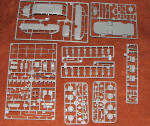Roden 1/72 Opel Blitzbus - Ludewig 'Aero' (WWII
Service)
|
KIT #: |
728 |
|
PRICE: |
$19.99
|
|
MARKINGS: |
Two options |
|
REVIEWER: |
Scott Van Aken |
|
NOTES: |
|

At the beginning of the 1930's Germany gradually recovered after the
protracted economic depression caused by the aftermath of WWI and the stormy
political events of the Twenties. The rise of Adolf Hitler, who set out the
goal of renewing the political role and importance of Germany, which it had
had before the Great War, became the spur for a rapid growth in diverse
sectors of industry, including the automobile industry. However, Germany,
although the motherland of the automobile as such, had allowed other
countries to take up the leadership of the motor industry during the early
years of the 20th Century; first of all France and England, and these
countries had become the trendsetters in motor vehicle development.
In the middle of the Thirties the renowned designer Ferdinand Porsche
proposed the concept of a "folk car" to Hitler. He developed a small
automobile, which then became one of the classics of the motor industry, the
VW Beetle. The elegant contours of this car inspired a real boom among
German auto designers. Cars of previous years had a body of distinct and
separate forms, amongst which were distinguished a hood, rear body, boot,
etc. Now a preference was given to the construction of cutting edge
aerodynamic forms, and soon these new features were widespread not only on
automobiles but also on trucks, buses and even passenger-trains.
The small truck body workshop of Ludewig Brothers in the German city of
Essen had been installing bodies of their own design on the chassis base of
trucks from the leading German motor manufacturers for some years. In the
1930's the Ludewig firm cooperated especially closely with the Opel business
concern. After the appearance of the Opel Blitz three ton truck the Ludewig
Brothers workshop developed a few new conceptual bodies for this vehicle.
One of them was a bus of incredibly stylish exterior with an oval front end
treatment, and finishing off with an aerodynamic fin behind.
This unusual bus did not only have a futuristic exterior. Passengers were
situated inside on luxurious chairs more like what you would find in a hotel
with a section in the rear of plush couch-like bench seats. Like the earlier
aero bus, the forward seats were positioned at an angle of 45 degrees to the
windows. It was considered that buses of this type would carry out excursion
trips, and passengers would benefit from an excellent view out of the bus
through the large panoramic side and overhead windows.
In the middle 1930's the truck body workshop of Ludewig Brothers constructed
a small production batch of these vehicles. Even for that time their
production was expensive, and that is why the workshop did not receive large
orders for them. These machines were widely used for propaganda motor races
on the newly built autobahns. A few were delivered to ODI, a transport firm,
for intercity travel.
Apart from civilian service, buses of this type were taken over for military
purposes. At least one of these was used by the German Army, mostly used to
transport higher ranking officers. Its civilian paint scheme replaced with a
more drab grey.
 This is
basically a repeat of an earlier kit but with different decals. The quality of
the moldings is quite good and with careful building will make a most impressive
display.
This is
basically a repeat of an earlier kit but with different decals. The quality of
the moldings is quite good and with careful building will make a most impressive
display.
The kit has a full engine as well as a complete and separate frame and
suspension along with a full exhaust system. The tires and wheels are a single
molding with well defined wheel/tire separation. Once the frame and suspension
is completed, then the body can be built up and added to it. The body has a
separate upper section and side panels to which is attached the rear part and
the fin. Despite having a full engine, there is not any separate hood. The
engine will, however, be quite visible from the underside of the bus. A sheet of
pre-printed acetate is provided for the interior windows.
The decals consist of license plates for two vehicles
that were repainted in panzer grey.The painting instructions on the back
of the box show two vehicles that differ only in the plates. Instructions are well drawn leaving no doubt as to what
goes where.
These are very cool kits and the perfect scale for a bus as these tend to be
rather large. If you are tired of the usual, this one will make a very nice
break from the norm and look quite pleasing on your display shelf.
www.roden.eu
May 2013
Thanks to Squadron Products
for the preview kit. You can find this kit at your favorite hobby shop
or on-line retailer.
If you would like your product reviewed fairly and fairly quickly, please
contact
the editor or see other details in the
Note to
Contributors.
Back to the Main Page
Back to the Previews Index Page


 This is
basically a repeat of an earlier kit but with different decals. The quality of
the moldings is quite good and with careful building will make a most impressive
display.
This is
basically a repeat of an earlier kit but with different decals. The quality of
the moldings is quite good and with careful building will make a most impressive
display.